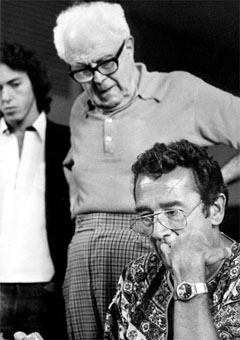|
| Magriel's NYT Columns |

Jason Lester (background) and
Oswald Jacoby look on as Gino
Scalamandre is playing. Last April the World Backgammon Club sponsored the ninth annual tournament for the important Wacker Cup in St. Martin, in the West Indies. In the finals Jason Lester made a dramatic comeback to beat Prince Alexis Obolensky Jr. After trailing 18 to 4, Lester won the cup, 25 to 21.
Lester, from Montreal, is only 19 and looks even younger — hence his nickname, “Baby Jason.” However, his youthful appearance belies his skill as an exceptionally strong natural player, one of the rising stars of the game. In the diagrammed position, Lester demonstrated his fine grasp of endgame technique.
Earlier in the game, White (Obolensky) had anticipated gammoning Black (Lester) but unfortunately was forced to leave a man exposed after already bearing off 12 men. White was hit and reentered on the 1-point, as shown in the diagram.
|
| Black to play 4-1. |
One possible strategy for Black is to seek a closeout (that is, close all his home board points and keep White on the bar) by playing 5/1*, 2/1*. This strategy is reasonably assured of success, because only the 2-point is open and, besides, White’s man is still trapped behind Black’s 5-point prime. This will at least save the gammon for Black.
Yet, with the closeout he will still lose the game. Black himself will eventually begin to bear off and so open points in his home board. White, with 12 men off, will almost certainly reenter and bring his last man around in time to win the race.
The obvious play for a quick decision is 7/2. If White rolls a 1, he is prevented from playing 1/2. Now 1’s (except 1-1 and 6-1) will force White to play 23/24*, leaving the deadly double shot. Thus eight numbers (2-1, 3-1, 4-1 and 5-1) achieve the desired result immediately. However, the play is unacceptably dangerous: If White rolls a 6 before he rolls a 1, he will escape into Black’s outer board and hit Black; then Black may be facing the gammon again. Worse yet, there is the nasty possibility that White may roll 6-6 and sweep around the board, backgammoning Black!
Lester found a better way to try to make White break immediately with 1’s, a play that is both more effective and less dangerous than 7/2.
The correct play is 18/14, 3/2. Black “switches” from the 3-point to the 2-point (in other words, he breaks the 3-point to make the 2-point). Now all 1’s (except 1-1) force White to play 23/24*, so White will break on 10 numbers (as opposed to 8 numbers if 7/2 is played). More importantly, the play is clearly safer than 7/2, because only four numbers (2-5 and 2-6) allow White to escape from Black’s home board.
Rollout
 Tom Keith 2013 |
|
Money play Black owns 2-cube Black rolls 4-1 1296 games with VR Checker play: 2-ply Cube play: 3-ply Red |
| 4-1: | Game | G | BG | Equity | ||||
| 1 | 18/14, 3/2 |
W L |
.4491 .5509 |
.0000 .1083 |
.0000 .0346 | −0.0457 |

| (b) |
| 2 | 18/13 |
W L |
.3914 .6086 |
.0000 .0892 |
.0000 .0290 | −0.1631 | (0.1174) | |
| 3 | 24/20, 3/2 |
W L |
.4002 .5998 |
.0000 .1115 |
.0000 .0282 | −0.1634 | (0.1177) | |
| 14 | 7/2 |
W L |
.3520 .6480 |
.0000 .2052 |
.0000 .0849 | −0.4381 | (0.3924) | (a) |

|
|

